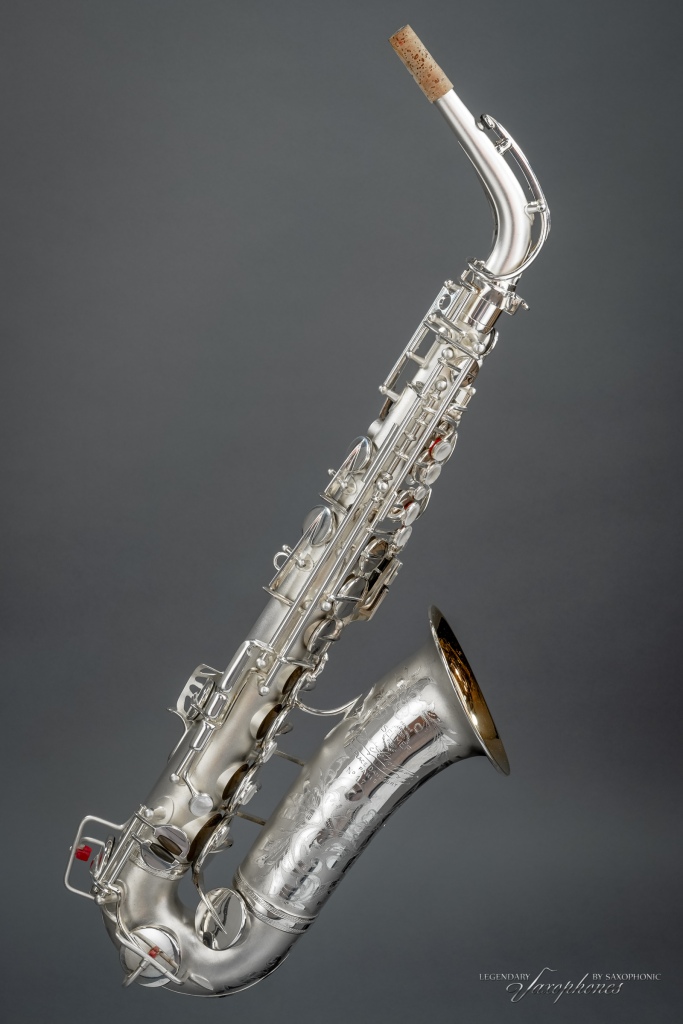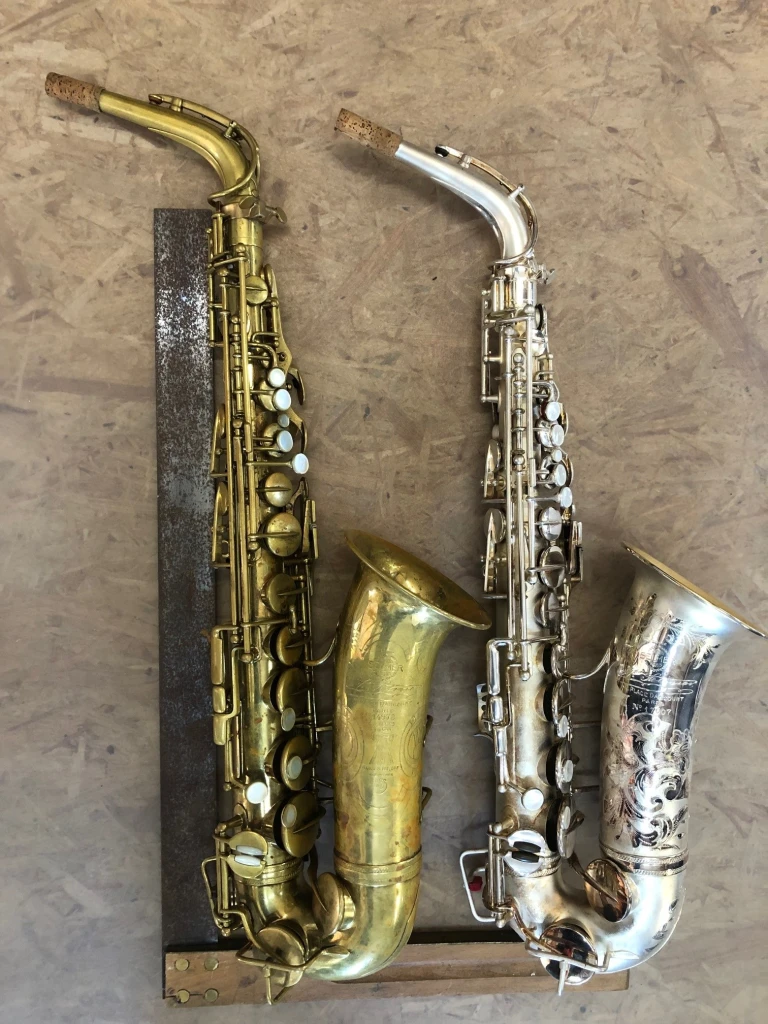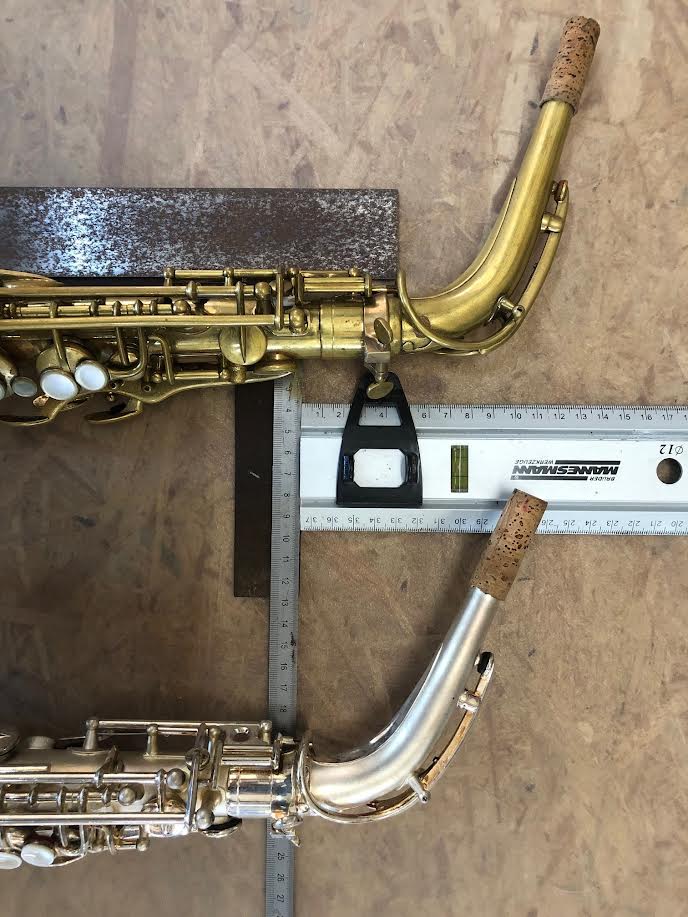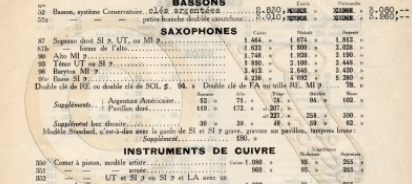
I always enjoy hearing feedback from saxophonists who like this historical project, but sometimes the feedback leads to more research. Yesterday, I received an email from Frank R. in the Netherlands. Frank informed me he is the owner of a Selmer Cigar Cutter saxophone tuned in E. The saxophone also has an additional stamp, AD, on the saxophone. Have I found any works for an E alto saxophone in my research?
A saxophone tuned in E? Of course I had to know more. Frank’s repairman, Reiner Diehl, owner of Saxophonic Legendary Saxophones in Germany filled me in with more details. Diehl contacted the Selmer historian, Douglas Pipher, to learn more about this model. In the Selmer archives, there are 6 alto saxophones inscribed with the letter AD like in the model above. The leading theory is that AD is specifically for orchestral saxophones. The AD model was produced in the 17006-17020 serial number range. In the photo below, you can see the number 17007 stamped on saxophone on the right. The other saxophone in the photo is a Cigar Cutter alto in E flat with the serial number 147978. The E flat saxophone is dated to 1931 while the E saxophone dates to 1932.

The detail that went into this saxophone is impressive. Selmer didn’t just cut the neck a few centimeters, they completely made a brand new saxophone. The bore size is smaller, the key work is slightly smaller, looking at the posts really makes it clear the difference in size between the two. In the picture below, measuring at the tendon screw, you can see how the body of the E flat is four centimeters longer than the E.

Selmer also made an AD soprano saxophone model. I don’t have any information on what the tuning is on the soprano, it could be either B flat or C since there are orchestral works with C soprano saxophone—Bolero by Ravel is the obvious example of that.[1] Selmer produced four AD sopranos in the serial number range of 14k-18k.
I checked the Selmer catalog from 1932 to see if there are any listings of Cigar Cutter in E or a AD saxophone. It’s a little blurry but you can see the full image at saxophone.org.

The first listing is straight Soprano in B flat, C, or Eb. The next is curved Soprano. Then Alto in Eb, Tenor in C or Bb, Baritone in Eb, Bass in Bb. The next add-ons are for trill keys, mouthpiece, and engraving. The three columns on the right are for finishes, copper, nickel, or silver. The E alto has a silver finish with additional engravings. Nowhere in the catalog does it indicate Selmer made the E alto or the AD model for the general public.
What we do know about this model from Douglas Pipher at Selmer is the AD saxophone was shipped to different countries: 1 to Spain, 2 to the Netherlands, 3 to France, and 4 to Belgium. This information provides me a good place to start looking. I have a hypothesis why this saxophone exist.
It’s possible that a composer, a composer influential enough to get Selmer to make a new saxophone, wrote an orchestral work for a saxophone in E. It’s more likely that it’s orchestral work since this saxophone was shipped to four different countries. Operas and ballets are larger endeavors and take time to stage. Looking at the numbers, I would guess that 1-4 orchestras played this work in Belgium, 1-3 orchestras played this work in France, 1-2 orchestras played this work in the Netherlands, and 1 orchestra played this work in Spain. So what is the piece?
The next step I would take is start researching Belgium orchestras. Starting in 1932, I would look in the newspapers of major cities, Brussels, Antwerp, etc. for music reviews or advertisements for the symphony. When I research this, I use general search terms: Saxophone+ any of the following combinations, orchestra, symphony, opera, premiere, etc. It’s possible just to make a list of the premieres of any new works of music by the major symphonies in 1932 then check to see if they have a saxophone part. Since I’m located in the United States I might not have access to research databases to find the information that I need. That’s why I might need help to find this work.
Once a piece of music is found, the next step is to go to Worldcat.org to see if the manuscript in any library. Since works from 1932 are not in public domain, the only way to find this score is the old fashioned way, at the library. If the saxophone is written in E, it will be in the manuscript. If this work is still performed, the E alto parts have probably been rewritten to E flat during the publishing process. It’s possible this work was played in 1932 and never heard from since.
Why does the E alto exist? Do you have any information that will solve this riddle? If so, please email me and so I can fill in the blanks.
If you are enjoying what you’ve read here, please donate! Any amount will keep this website running.
[1] Edit: I remembered the soprano for Bolero is not in B flat, I forgot that it is actually written for F Sopranino. If you ever find yourself playing Bolero on Soprano, just read the tenor part. For more information on C saxophone, I have 5 examples of that in the database, but there could be more.
I have a theory about the “AD” stamping on the Selmer E alto sax. After trying several combinations in an English to French translation app, I found that “Alternative Fingering” is “Doigté Alternatif”. I’m wondering, as are some friends, if Selmer was simply trying to create a line of alternate saxophones just as they had successfully done with the Bb and A clarinets. In symphonic music, many “string key” pieces are written for the clarinet in A, which puts the written parts in easier keys with less sharps.
While there was some use of saxophones in symphonic music in 1930, it never really caught on much. Perhaps Selmer abandoned the project when they accepted that there wasn’t much of a market.
LikeLike
Thanks for replying. That is the reason the owner reached out to me, to see if I found any pieces in a different key. I can’t find any evidence of that. When going back to Sax’s original design, he thought saxophones tuned to C and F would be used in orchestras. The versality of the Eb and Bb saxophone made the use of the C and F obsolete. However, Richard Strauss did write for C and F in his Symphonia Domestica. Please read the followups to this article to see what I’ve found.
LikeLike